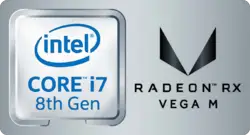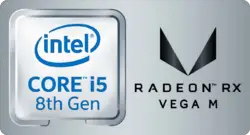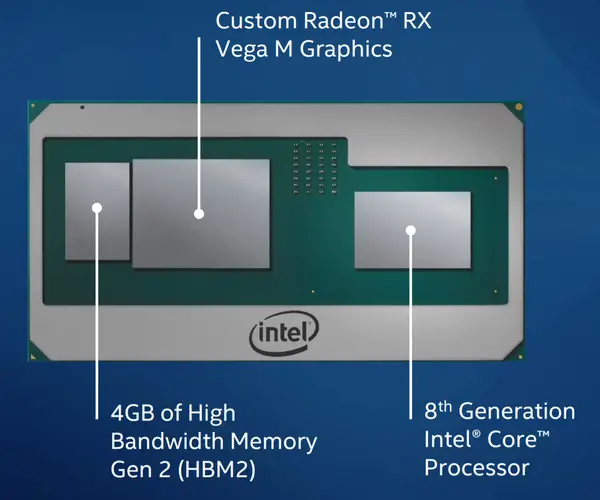(→Overview) |
|||
| Line 24: | Line 24: | ||
== Overview == | == Overview == | ||
| + | [[File:8th gen core i7 with radeon logo (2018).png|250px|right]] | ||
| + | [[File:8th gen core i5 with radeon logo (2018).png|250px|right]] | ||
Kaby Lake G based processors are a 2-chip solution - the [[microprocessor]] and the [[chipset]]. Those parts are [[BGA]] and are soldered onto the motherboard. The microprocessor is connected to the chipset via 4 of the chip's 20 PCIe lanes using Intel's proprietary {{intel|Direct Media Interface}} 3.0 (DMI 3.0), allowing for 8 GT/s transfer rate per lane. | Kaby Lake G based processors are a 2-chip solution - the [[microprocessor]] and the [[chipset]]. Those parts are [[BGA]] and are soldered onto the motherboard. The microprocessor is connected to the chipset via 4 of the chip's 20 PCIe lanes using Intel's proprietary {{intel|Direct Media Interface}} 3.0 (DMI 3.0), allowing for 8 GT/s transfer rate per lane. | ||
Revision as of 19:54, 6 January 2018
| Edit Values | |
| Kaby Lake G | |
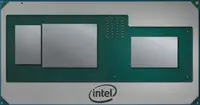 | |
| Package front | |
| General Info | |
| Designer | Intel, AMD |
| Manufacturer | Intel, GlobalFoundries |
| Introduction | November 6, 2017 (announced) January 7, 2018 (launched) |
| Microarchitecture | |
| ISA | x86-64 (x86) |
| Microarchitecture | Kaby Lake |
| Word Size | 8 octets 64 bit16 nibbles |
| Process | 14 nm 0.014 μm 1.4e-5 mm |
| Technology | CMOS |
Kaby Lake G (KBL-G) is the name of the core for Intel's high-performance line of mobile processors based on the Kaby Lake microarchitecture and incorporate a discrete AMD Vega graphics processor. These chips are targeted towards ultimate mobile gaming experience. Kaby Lake G processors are fabricated on Intel's enhanced 14nm+ process and for graphics, GlobalFoundries 14 nm process.
Overview
Kaby Lake G based processors are a 2-chip solution - the microprocessor and the chipset. Those parts are BGA and are soldered onto the motherboard. The microprocessor is connected to the chipset via 4 of the chip's 20 PCIe lanes using Intel's proprietary Direct Media Interface 3.0 (DMI 3.0), allowing for 8 GT/s transfer rate per lane.
Graphics
Those processors are unique in the fact that this is the first time Intel has integrated a discrete graphics processor into the same package as the microprocessor. This is also the first time they are using a competitor graphics processor. Those parts incorporate an AMD GPU based on the Vega microarchitecture and incorporate their own 4 GiB of high-bandwidth memory 2 (HBM2). The HBM solution is connected to the graphics processor using Intel's EMIB, a high-speed in-package interconnect solution.
The CPU itself is connected to the GPU using 8 of the other PCIe lanes, leaving the 8 remaining lanes for other peripherals to communicate with the CPU directly.
Common Features
All Kaby Lake G processors have the following:
- Dual-channel Memory
- Up to DDR3L-1600, DDR4-2400
- Up to 64 GiB
- 8x PCIe
- 20x in total, 4 of the 20 are used by the bus and 8 for the GPU as described above
- quad-core with Hyper-Threading (8 threads)
- Everything up to AVX2 (SMM, FPU, NX, MMX, SSE, SSE2, SSE3, SSSE3, SSE4.1, SSE4.2, AES, AVX, and AVX2)
- Graphics
- Integrated HD Graphics 630 (Gen9.5 GT2)
- Base frequency of 350 MHz
- Burst frequency of 1.1 GHz
- Discrete Vega-based GPUs
- Custom Radeon RX Vega M Graphics
- Radeon RX Vega M GH (24 CUs)
- Radeon RX Vega M GL (24 CUs)
- Custom Radeon RX Vega M Graphics
- Integrated HD Graphics 630 (Gen9.5 GT2)
- BGA package
Kaby Lake G Processors
| List of Kaby Lake G-based Processors | ||||||||||||
|---|---|---|---|---|---|---|---|---|---|---|---|---|
| Main processor | Graphics Processors | |||||||||||
| Model | Price | Launched | Family | C | T | L3$ | TDP | Frequency | Turbo | GPU | Base | iGPU Burst |
| i5-8305G | 7 January 2018 | Core i5 | 4 | 8 | 6 MiB 6,144 KiB 6,291,456 B 0.00586 GiB | 65 W 65,000 mW 0.0872 hp 0.065 kW | 2.8 GHz 2,800 MHz 2,800,000 kHz | 3.8 GHz 3,800 MHz 3,800,000 kHz | HD Graphics 630, Radeon RX Vega M GL | 350 MHz 0.35 GHz , 931 MHz350,000 KHz 0.931 GHz 931,000 KHz | 1,100 MHz 1.1 GHz , 1,011 MHz1,100,000 KHz 1.011 GHz 1,011,000 KHz | |
| i7-8705G | 7 January 2018 | Core i7 | 4 | 8 | 8 MiB 8,192 KiB 8,388,608 B 0.00781 GiB | 65 W 65,000 mW 0.0872 hp 0.065 kW | 3.1 GHz 3,100 MHz 3,100,000 kHz | 4.1 GHz 4,100 MHz 4,100,000 kHz | HD Graphics 630, Radeon RX Vega M GL | 350 MHz 0.35 GHz , 931 MHz350,000 KHz 0.931 GHz 931,000 KHz | 1,100 MHz 1.1 GHz , 1,011 MHz1,100,000 KHz 1.011 GHz 1,011,000 KHz | |
| i7-8706G | 7 January 2018 | Core i7 | 4 | 8 | 8 MiB 8,192 KiB 8,388,608 B 0.00781 GiB | 65 W 65,000 mW 0.0872 hp 0.065 kW | 3.1 GHz 3,100 MHz 3,100,000 kHz | 4.1 GHz 4,100 MHz 4,100,000 kHz | HD Graphics 630, Radeon RX Vega M GL | 350 MHz 0.35 GHz , 931 MHz350,000 KHz 0.931 GHz 931,000 KHz | 1,100 MHz 1.1 GHz , 1,011 MHz1,100,000 KHz 1.011 GHz 1,011,000 KHz | |
| i7-8709G | 7 January 2018 | Core i7 | 4 | 8 | 8 MiB 8,192 KiB 8,388,608 B 0.00781 GiB | 100 W 100,000 mW 0.134 hp 0.1 kW | 3.1 GHz 3,100 MHz 3,100,000 kHz | 4.1 GHz 4,100 MHz 4,100,000 kHz | HD Graphics 630, Radeon RX Vega M GH | 350 MHz 0.35 GHz , 1,063 MHz350,000 KHz 1.063 GHz 1,063,000 KHz | 1,100 MHz 1.1 GHz , 1,190 MHz1,100,000 KHz 1.19 GHz 1,190,000 KHz | |
| i7-8809G | 7 January 2018 | Core i7 | 4 | 8 | 8 MiB 8,192 KiB 8,388,608 B 0.00781 GiB | 100 W 100,000 mW 0.134 hp 0.1 kW | 3.1 GHz 3,100 MHz 3,100,000 kHz | 4.2 GHz 4,200 MHz 4,200,000 kHz | HD Graphics 630, Radeon RX Vega M GH | 350 MHz 0.35 GHz , 1,063 MHz350,000 KHz 1.063 GHz 1,063,000 KHz | 1,100 MHz 1.1 GHz , 1,190 MHz1,100,000 KHz 1.19 GHz 1,190,000 KHz | |
| Count: 5 | ||||||||||||
See also
|
• Power
• Performance |
| designer | Intel + and AMD + |
| first announced | November 6, 2017 + |
| first launched | January 7, 2018 + |
| instance of | core + |
| isa | x86-64 + |
| isa family | x86 + |
| main image | 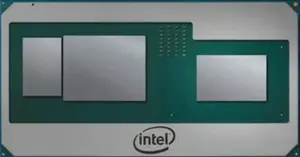 + + |
| main image caption | Package front + |
| manufacturer | Intel + and GlobalFoundries + |
| microarchitecture | Kaby Lake + |
| name | Kaby Lake G + |
| process | 14 nm (0.014 μm, 1.4e-5 mm) + |
| technology | CMOS + |
| word size | 64 bit (8 octets, 16 nibbles) + |
